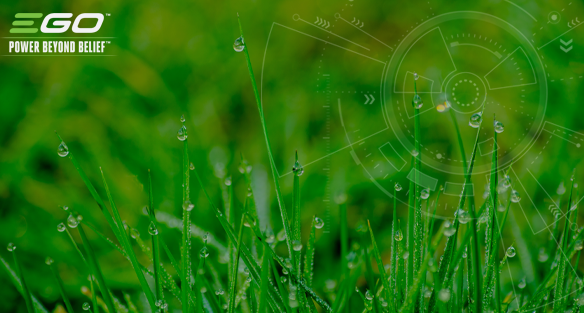Why feed your lawn
Grass loves the heat and moisture of summer and will grow fast between April and September. During this time, your cordless lawnmower will be keeping it under control, with a mow once a week or every two weeks.
At first, your grass will appear lush but it’s likely to run out of nutrients - this growth boost will quickly use up the soil’s nutrients.
Feeding your lawn will also allow the grass to grow more thickly, encouraging it not to grow just upwards, but to grow outwards with shoots - this helps prevent weeds from moving in.
A good food will also strengthen its roots, making it more resilient to scarcity of water later on in the season.
When to feed your lawn
Summer weather can be unpredictable. As a guide, you want to feed your lawn when it’s warm enough to encourage growth.
You might have noticed, during excessively hot or prolonged periods of sunny weather, your grass will stop growing as it turns its priority to coping with the heat stress.
Feeding during this time is a waste - the grass won’t absorb it until it feels the period of drought is over. In this case, just keep watering to support your lawn’s efforts to survive.
How to feed your lawn
With shop-bought fertiliser
Your lawn will require varying amounts of nitrogen, phosphate and potassium to grow well, stay healthy and keep it resilient to the stresses of summer and winter too. Lawns need this combination of nitrogen, phosphorus and potassium to stay healthy. However, you probably only need to feed it well once a season.
- Nitrogen grows strong shoots and dense growth
- Phosphorus grows a strong root system
- Potassium helps the grass stay healthy, so it can stand up to threats like drought, disease, children’s ball games and pets
See more tips on the overall health of your lawn during summer on our recent ‘Lawn care in summer’ guide.
Types of feed or fertiliser
Lawn food or fertiliser comes as granules, water soluble, and liquid.
- Granular lawn feed - you can distribute this across your lawn by hand or by using a spreader. It will get rained in or you can water it in by hand.
- Water soluble lawn feed - this is a dry product that you will need to mix with water before applying it to your lawn using a knapsack or spreader.
- Liquid lawn feed - this ready-mixed product will need to be applied with the assistance of a boom sprayer or knapsack.
Lawn feeds also differ in their approach.
- Synthetic feeds are manufactured using minerals, gasses from the air and inorganic waste materials. Their benefits include fast release of nutrients and a visible improvement in your lawn.
- Organic feeds are forumated from natural ingredients like composted plants, manure, animal bones and blood. If you’re an advocate of a gentler approach to gardening, you might be willing to wait a bit longer to see results from this type of fertiliser.
Prepare your lawn
A little planning and consideration will help you get better results from your lawn feed.
- Scarify, rake and mow your lawn a few days before you plan to apply your feed.
- Check how much feed you need to apply - be careful not to over-feed.
- If you’re using a dry product and there’s not a cloud in the sky, water it in over a few days.
Through natural gardening practices
If you want to try a natural approach, as well as (or instead of) using organic lawn feed, you can introduce some environmentally-friendly practices.
- Sow microclover or Dutch (dwarf) white clover into your lawn. This feeds your grass with nitrogen and makes it more robust so that, even in the summer, it’s less likely to suffer from heat and water stress.
- Dandelions also add nutrients to your lawn - and you can eat them on salads!
- Set your lawn mower cutting height at the top end. By not cutting your grass right down, you’ll protect the roots, prevent evaporation and encourage more diversity of plants that add nutrients and resilience to your lawn. Our range of cordless lawnmowers incorporates cutting heights from 20mm to 95mm, depending on the model.
- Leave clippings on top to decompose naturally, adding nutrients back into the soil. If you trim your lawn regularly, the clippings will be smaller and will decay quite quickly, so they don’t accumulate and cause an issue.
- See our guide on ‘Lawn care for eco friendly gardeners’ for more tips and also our guide to ‘Using recycled household water on your lawn’ during drought conditions.
What is your environmental impact?
On the subject of environmentally-friendly practices, we’ve created a helpful emissions calculator to highlight the impact using petrol-powered tools has on the environment.
We undertook rigorous testing to decipher the volumes of:
- CO2 mass (kg)
- CO2e (kg)
- Particulate (#)
- Fuel consumption (litres)
when using your petrol-powered tools on a weekly, monthly, and yearly scale.
To put this into perspective, it also shows the output in how many miles you could travel by car for that amount of fuel and how many trees you would need to plant to offset your emissions.
Choosing cordless makes sense
The good news is, there are things you can do to reduce your emissions and, in turn, help the environment.
Battery technology has evolved, and you can now benefit from not only less emissions, but less vibration and less noise too. One battery fits every EGO cordless garden tool, and with long run times, there really is no better time to make the switch.
